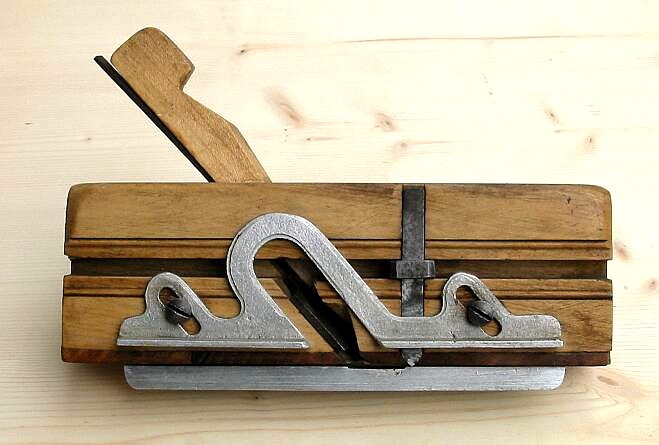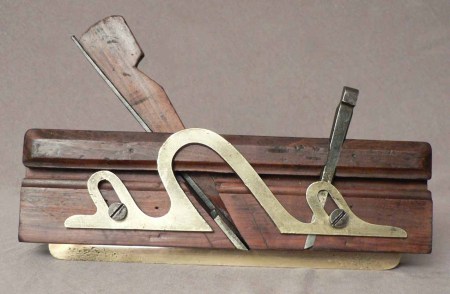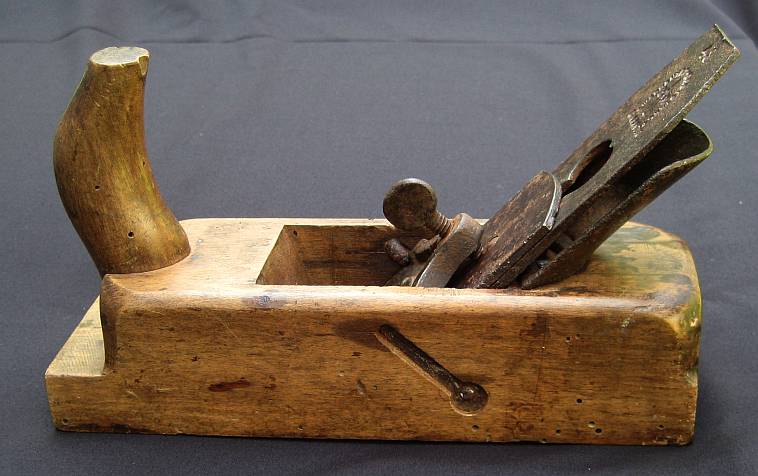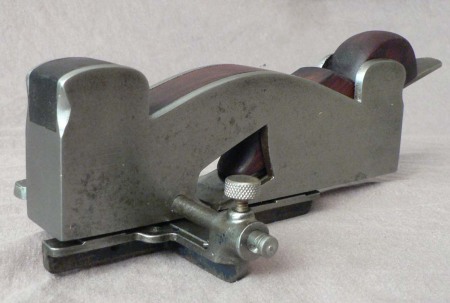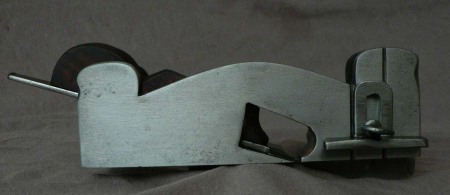Hi everybody - I have taken refuge from the tropical heat for a little while, and have found myself irresistibly drawn back to the Universal Hobel.
So, let's start with the blade. I don't think it will win any prizes, but how many other planes can boast a painted blade and cap iron, eh? I managed to find a line in between the pits in the steel which I could make sharp enough for my experiments; filed the paint off the business end of the cap iron, and reassembled it all.
I forgot to point out that the front of the plane is moveable, giving it an adjustable mouth:

This is where we hit a bit of a snag. The back of the movable bit is at 90° to the sole, so if you slide it forward to make a wide mouth, the shavings all pack up into the space under the overhang:

This isn't so bad if you take a thicker shaving, or set the mouth a bit narrower:

It was pretty hopeless as a smoother on a wide surface - especially as I had sharpened the blade with no camber and sharp corners. Not too bad on the edge of a board, and surprisingly ok on end grain, which crumbled in the mouth without clogging. What about using it with the fences on, as a fillister plane? The bottom fence only slides far enough to take a cut of about 28mm, which is a fault which could have been designed out but wasn't. I sharpened the nicker and held a bit of scrap pine fast to the bench:

This sort of cross-grain work was actually ok:

This shows the sort of finish on soft pine:

(I take the blame for the ding from the depth stop.) It's not a show surface, but would be fine for something like the top ends of a door casing.
I tried a rebate with the grain, on the same settings. I left the nicker in place for a few strokes, which defined a clear line through the knot. Here's an 'action shot'

and here's the finish - showing the visible nicker line from the previous cut. (Stop sniggering at the back!)

As a comparison, I tried cleaning up the rebate with a specialist rebate plane from one of England's most respected makers, and I don't think it could make any improvement:

So, overall, it does work, and would be fine for joinery work in softwood. The quality of the finish is strictly functional - steel threaded inserts and polyurethane varnish. It's reasonably easy to hold and use. (Btw, thanks to Douglas for identifying the faux-ivory handles - that's not a material I was very familar with.) The cuts were square and flat without having to try very hard. The big, depth-adjustable nicker is better than the tiny ones on metal planes and easier to use then the English wedged equivalent.
So, I might use it a bit if I do some shed building or suchlike, though I expect I'd prefer my old C19th English moving fillister, or a 78/778. I guess this is really the degenerate descendant of some of the really nice old tools in the European tradition, like this one, which I have shown on here before:

so overall I think I'll keep it.
And I hope that last picture took away any nasty taste left by the others!
So, let's start with the blade. I don't think it will win any prizes, but how many other planes can boast a painted blade and cap iron, eh? I managed to find a line in between the pits in the steel which I could make sharp enough for my experiments; filed the paint off the business end of the cap iron, and reassembled it all.
I forgot to point out that the front of the plane is moveable, giving it an adjustable mouth:

This is where we hit a bit of a snag. The back of the movable bit is at 90° to the sole, so if you slide it forward to make a wide mouth, the shavings all pack up into the space under the overhang:

This isn't so bad if you take a thicker shaving, or set the mouth a bit narrower:

It was pretty hopeless as a smoother on a wide surface - especially as I had sharpened the blade with no camber and sharp corners. Not too bad on the edge of a board, and surprisingly ok on end grain, which crumbled in the mouth without clogging. What about using it with the fences on, as a fillister plane? The bottom fence only slides far enough to take a cut of about 28mm, which is a fault which could have been designed out but wasn't. I sharpened the nicker and held a bit of scrap pine fast to the bench:

This sort of cross-grain work was actually ok:

This shows the sort of finish on soft pine:

(I take the blame for the ding from the depth stop.) It's not a show surface, but would be fine for something like the top ends of a door casing.
I tried a rebate with the grain, on the same settings. I left the nicker in place for a few strokes, which defined a clear line through the knot. Here's an 'action shot'

and here's the finish - showing the visible nicker line from the previous cut. (Stop sniggering at the back!)

As a comparison, I tried cleaning up the rebate with a specialist rebate plane from one of England's most respected makers, and I don't think it could make any improvement:

So, overall, it does work, and would be fine for joinery work in softwood. The quality of the finish is strictly functional - steel threaded inserts and polyurethane varnish. It's reasonably easy to hold and use. (Btw, thanks to Douglas for identifying the faux-ivory handles - that's not a material I was very familar with.) The cuts were square and flat without having to try very hard. The big, depth-adjustable nicker is better than the tiny ones on metal planes and easier to use then the English wedged equivalent.
So, I might use it a bit if I do some shed building or suchlike, though I expect I'd prefer my old C19th English moving fillister, or a 78/778. I guess this is really the degenerate descendant of some of the really nice old tools in the European tradition, like this one, which I have shown on here before:

so overall I think I'll keep it.
And I hope that last picture took away any nasty taste left by the others!





